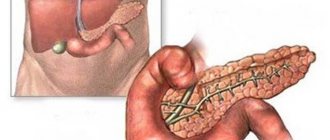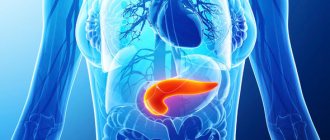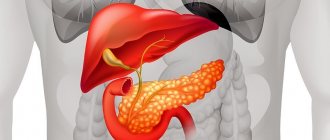What is insulin?
In its chemical structure, insulin is a peptide hormone. Its active form consists of two chains of polypeptides that are connected by disulfide bridges.
In the human body, this substance performs the following work:
- helps glucose entering the blood pass through liver, fat and muscle cells;
- activates enzyme compounds involved in the oxidation of glucose in cells;
- inhibits the production of monosaccharides from proteins and fats;
- participates in the conversion of glucose into liver and muscle glycogen;
- stimulates protein synthesis and prevents the formation of ketones from amino acids;
- helps form triglycerides and deposit them;
- accelerates the passage of potassium and magnesium into cells.
Important! Insulin is produced by beta cells of the islets of Langerhans, which are diffusely located in the pancreas. They are a special type of structure that does not have ducts, unlike the parenchymal cells of the pancreas, and secretes the hormone directly into the blood.
To understand how to help the pancreas produce insulin, it is necessary to understand the mechanism of its release. This hormone is produced in response to a certain amount of sugar entering the blood. Its inhibitors are cortisol, ACTH, and adrenaline. A decrease in insulin production also occurs in response to an increase in its level in the blood above normal and as a result of hypoglycemia.
Where does insulin production take place?
- For increase:
The pancreas is made up of various tissues, a system of ducts, and several types of cells. One of them are beta cells located in pancreatic islets, named after the scientist Langerhans. This hormone is produced in them.
The parts that make up the pancreas:
- Head. It is located to the right of the center line and fits tightly to the duodenum.
- Body – considered the main part. In shape it resembles a prism-like trihedron.
- Tail. Beta cells are located in this part.
Functions of the organ:
- Endocrine. This function is to produce 5 hormones.
- Exocrine. This action of the gland is based on the release of amylase, protease, lipase through the existing ducts leading into the organ cavity. Substances take part in the digestion of food.
Mechanism of hormone production:
- insulin is produced from the moment the amount of carbohydrates received from food increases;
- after secretion, the hormone penetrates alternately into the pancreatic and hepatic veins, and then passes into the bloodstream;
- The hormone content decreases during fasting.
Causes and symptoms of decline
A natural question is why in some cases the pancreas does not produce insulin. It is known that the cause of this is various diseases and abnormalities:
- Poor nutrition with overeating, a predominance of animal fats, easily digestible carbohydrates, and pastry products. In this case, the organ cannot cope with the high load. Fasting and strict diets also disrupt the functioning of the gland.
- Diseases in which cellular atrophy occurs: chronic and acute pancreatitis, cholecystitis, stones and neoplasms, consequences of operations.
- Vascular sclerosis causing cell ischemia.
- Infections and intoxications of a chronic nature, severe acute poisoning.
- Metabolic disorder.
- Hereditary characteristics, congenital abnormalities in the structure of the pancreas.
- Lack of protein, zinc, excess iron.
- Cyanide poisoning.
Important! Constant stress, poor lifestyle, alcohol abuse or drug use can provoke the destruction of beta cells and reduce insulin production.
If there is a failure in insulin production, the following symptoms are observed:
- increased volume of urine, especially at night;
- constant thirst and dry mouth;
- weight loss with normal appetite;
- drowsiness, weakness;
- itchy skin.
Radical treatment methods
Treating the pancreas with diabetes is not easy. It is also necessary to take into account that when this organ is inflamed, its functional elements are practically not restored by conservative therapy. With this outcome, the attending physician may recommend the following radical ways to combat this problem to the patient:
- Hardware therapy methods.
- Whole organ transplantation.
- Transplantation of functional elements of the gland (islets or Langerhans cells).
Transplantation of the pancreas for diabetes mellitus or its functional units can help normalize metabolic processes disturbed due to pathology, as well as prevent the development of secondary complications of the disease.
How to force the pancreas to produce insulin?
If beta cells are not destroyed as a result of the disease and retain the ability to produce insulin, then its production can be stimulated. Some drugs are used for this:
- Januvia (sitagliptin) or Galvus (vildagliptin). These drugs block the action of an enzyme substance (DPP-4) that binds glucagon-like peptide-1. The latter is released in the intestines under the influence of incoming food and stimulates the formation of insulin. DPP-4 blockers are taken once daily but only work with food. This helps prevent the development of hypoglycemia.
- "Bayeta" (exenatide) or "Victoza" (liraglutide) . Help stimulate the formation of insulin by enhancing the production of glucagon-like peptide. They are also active only during meals and do not affect basal blood sugar levels. They are administered in the same way as insulin (subcutaneously).
- "Glucobay" (acarbose). Often used for type 2 diabetes as a hypoglycemic agent. The mechanism of its action is to slow down the absorption of glucose by the intestines and the process of its absorption. This helps reduce the load on the pancreas. But acarbose does not have a direct effect on increasing insulin production. Therefore, in this case, we are talking not so much about how to force the pancreas to produce insulin, but about reducing the body’s need for its production.
Important! Folk remedies do not help with severe forms of impaired glucose metabolism and insulin production. Therefore, they are used primarily as an adjunct to therapy to reduce inflammation in the gland and improve digestion.
3A century-long search
Throughout the twentieth century, scientists looked for ways to compensate for the lack of the hormone from the outside. Until the 20s, strict diets were used to treat diabetes, but all searches for a perfect diet turned out to be unsuccessful.
In 1921, Canadian researchers succeeded for the first time in extracting a hypoglycemic substance, insulin, from the tissues of the pancreas of dogs. Already next year the first patient receives it, and the discoverers of the hormone F.
Banting and J. McLeod - Nobel Prize.
15 years later, Hans Christian Hagedorn discovers the first long-acting insulin, NPH insulin (neutral protamine Hagedorn), later widely used in clinical practice. By the middle of the century, it was possible to decipher the chemical structure of the hormone with the exact sequence of amino acids that form the insulin molecule, and 40 years later, researchers were able to determine the spatial structure of the hormone molecule.
In 1982, genetic engineering creates an analogue of the human pancreatic hormone, synthesized by special non-pathogenic rod-shaped bacteria, into the genome of which the human insulin gene is inserted. Three years later, the first human insulin appears on the market. Previously, porcine and bovine insulin were used.
Research work continued, and by the end of the century analogues of human insulin appeared, becoming increasingly popular with doctors and patients. This is quite understandable:
- Industrial insulin is highly effective.
- The drugs are safe.
- Analogues are convenient to use.
- Dosage calculations and synchronization of the drug with the body’s own hormone secretion have been simplified.
Modern insulin therapy is based on determining individual dosages of a specific brand of insulin, since ready-made hormonal products differ in the number of injections, patterns of use, combinations of different types of insulin, and the method of delivering the hormone to the body. Insulin-dependent patients were able to significantly improve their quality and life expectancy.
How to lower its level?
To reduce insulin levels, diet and certain medications are prescribed. If an excess of the hormone is observed as a result of a tumor, it is necessary to resort to surgery.
Diet
A balanced diet with the exclusion of heavy and harmful foods: fast food, animal fats, processed foods helps maintain the balance of glucose in the body and the production of insulin . “Fast” carbohydrates are prohibited, including sweets, sweet pastries, honey, jam, and sugar.
It is best to take food often and in small portions. The menu should include unsweetened fruits, vegetables and high-fiber foods. Fatty sea fish, beans and lean meat are healthy. It is recommended to drink enough liquid throughout the day.
Drugs
To normalize insulin levels when they increase, the following groups of drugs are used:
- calcium inhibitors and antagonists (used to normalize blood pressure);
- hypoglycemic agents;
- statins (to control cholesterol levels);
- enzyme preparations that help digestion and reduce the load on the pancreas.
If hyperinsulinemia is observed due to the appearance of insulinoma, then the only option is excision of the tumor. But this tumor is extremely rare in clinical practice.
What are the types of diabetes?
Recently, you can increasingly hear that diabetes is an epidemic of the 21st century, that every year it is getting younger and more and more people are dying from its consequences. So let's understand what diabetes is, what types of diabetes exist, and how they differ from each other.
Diabetes is a whole group of diseases, the peculiarity of which is the release of large amounts of urine.
What types of diabetes are there? Diabetes is of two types due to its causes: diabetes mellitus, associated with high levels of glucose in the blood, and diabetes insipidus. Let's take a closer look at them.
Diabetes mellitus is a disease associated with elevated blood glucose levels for various reasons.
Depending on the cause of diabetes mellitus, the following types are distinguished:
- Diabetes mellitus type 1.
- Diabetes mellitus type 2.
- Specific types of diabetes.
- Gestational diabetes mellitus.
Let's look at the types of diabetes and their characteristics.
Diabetes mellitus type 1 (insulin dependent)
Type 1 diabetes develops due to a lack of insulin in the body, a hormone that regulates glucose metabolism. The deficiency occurs due to damage to pancreatic cells by the human immune system. After an infection, severe stress, or exposure to unfavorable factors, the immune system “breaks down” and begins to produce antibodies against its own cells.
Type 1 diabetes mellitus occurs more often in young people or children. The disease begins suddenly, the symptoms of diabetes are pronounced, the level of glucose in the blood is very high, up to 30 mmol/l, but without insulin the body's cells remain in a state of starvation.
Treatment
The only way to treat type 1 diabetes is to inject insulin under the skin. Thanks to modern advances, insulin no longer has to be injected many times a day. Insulin analogs have been developed that are administered from 1 time per day to 1 time every 3 days. Using an insulin pump, which is a small programmable device that delivers insulin continuously throughout the day, is also very effective.
A type of diabetes mellitus type 1 is LADA diabetes - latent autoimmune diabetes of adults. It is often confused with type 2 diabetes.
LADA diabetes develops in adulthood. However, unlike type 2 diabetes, it is characterized by decreased insulin levels in the blood and normal body weight. Also, during the examination, you can detect antibodies to pancreatic cells, which are not present in type 2 diabetes, but are present in type 1 diabetes.
It is very important to make a timely diagnosis of this disease, since its treatment involves the administration of insulin. Tablets of hypoglycemic drugs are contraindicated in this case.
Diabetes mellitus type 2 (non-insulin dependent)
In type 2 diabetes, insulin is produced by the pancreas in sufficient, even excessive, quantities. However, body tissues are not sensitive to its action. This condition is called insulin resistance.
This type of diabetes affects obese people over the age of 40, usually suffering from atherosclerosis and arterial hypertension. The disease begins gradually and occurs with a small number of symptoms. Blood glucose levels are moderately elevated, and antibodies to pancreatic cells are not detected.
A special insidiousness of type 2 diabetes is that due to the long asymptomatic period, patients go to the doctor very late, when 50% of them have complications of diabetes. Therefore, it is very important after 30 years to have an annual blood glucose test.
Treatment
Treatment for type 2 diabetes begins with weight loss and increased physical activity. These measures reduce insulin resistance and help lower blood glucose levels; for some patients this is enough. If necessary, oral hypoglycemic drugs are prescribed, and the patient takes them for a long time. As the disease worsens or serious complications develop, insulin is added to treatment.
Other specific types of diabetes
There is a whole group of types of diabetes associated with other causes. The World Health Organization identifies the following types:
- genetic defects in pancreatic cell function and insulin action;
- diseases of the exocrine pancreas;
- endocrinopathies;
- diabetes mellitus caused by drugs or chemicals;
- infections;
- unusual forms of immune diabetes;
- genetic syndromes combined with diabetes mellitus.
Genetic defects in pancreatic cell function and insulin action
This is the so-called MODU diabetes (Modi) or adult-type diabetes in young people. It develops as a result of mutation of genes responsible for the normal functioning of the pancreas and the action of insulin.
People of childhood and adolescence develop MODU diabetes, which is similar to type 1 diabetes, but the course of the disease resembles type 2 diabetes (asymptomatic, there are no antibodies to the pancreas, often diet and additional physical activity are sufficient for treatment).
Diseases of the exocrine pancreas
The pancreas consists of 2 types of cells:
- Endocrine, secreting hormones, one of which is insulin.
- Exocrine, producing pancreatic juice with enzymes.
These cells are located next to each other. Therefore, when part of an organ is damaged (inflammation of the pancreas, trauma, tumors, etc.), insulin production also suffers, which leads to the development of diabetes mellitus.
Such diabetes is treated by replacing the function, i.e., by administering insulin.
Endocrinopathy
In some endocrine diseases, hormones are produced in excess quantities (for example, growth hormone in acromegaly, thyroxine in Graves' disease, cortisol in Cushing's syndrome). These hormones have an adverse effect on glucose metabolism:
- increase blood glucose levels;
- cause insulin resistance;
- suppress the action of insulin.
As a result, a specific type of diabetes mellitus develops.
Diabetes mellitus caused by drugs or chemicals
Some medications have been shown to increase blood glucose levels and cause insulin resistance, contributing to the development of diabetes. These include:
- a nicotinic acid;
- thyroxine;
- glucocorticoids;
- some diuretics;
- α-interferon;
- β-blockers (atenolol, bisoprolol, etc.);
- immunosuppressants;
- drugs for the treatment of HIV infection.
Infections
Diabetes mellitus is often first diagnosed after a viral infection. The fact is that viruses can damage pancreatic cells and cause “breakdowns” in the immune system, triggering a process reminiscent of the development of type 1 diabetes.
These viruses include the following:
Only such a decoction will trigger REGENERATION of the thyroid gland
The goiter will disappear in 3 days! This remedy has become a sensation in the treatment of the thyroid gland!
- adenovirus;
- cytomegalovirus;
- coxsackievirus B;
- congenital rubella;
- mumps virus (“mumps”).
Unusual forms of immune diabetes
Types of diabetes caused by the formation of antibodies to insulin and its receptor are extremely rare. The receptor is the “target” of insulin through which the cell perceives its action. When these processes are disrupted, insulin cannot normally perform its functions in the body, and diabetes mellitus develops.
Genetic syndromes associated with diabetes mellitus
In people born with genetic syndromes (Down, Turner, Klinefelter syndromes), along with other pathologies, diabetes mellitus also occurs. It is associated with insufficient insulin production, as well as with its improper action.
Gestational diabetes mellitus
Gestational diabetes mellitus develops in women during pregnancy and is associated with the characteristics of hormone metabolism during this period. It usually occurs in the second half of pregnancy and occurs with virtually no symptoms.
The danger of gestational diabetes is that it causes complications that affect the course of pregnancy, fetal development and the health of the woman. Polyhydramnios, severe gestosis more often develop, the child is born prematurely, with greater weight, but with immature organs and respiratory disorders.
This type of diabetes responds well to diet and increased physical activity; insulin is rarely needed. After childbirth, glucose levels return to normal in almost all women. However, about 50% of women who had gestational diabetes mellitus will develop type 1 or type 2 diabetes mellitus over the next 15 years.
Diabetes insipidus
Diabetes insipidus is diabetes that is not associated with elevated blood glucose levels. It is caused by a violation of the metabolism of vasopressin, a hormone that regulates water exchange in the kidneys and causes vasoconstriction.
In the very center of our brain there is a small complex of glands - the hypothalamus and pituitary gland. Vasopressin is produced in the hypothalamus and stored in the pituitary gland. When these structures are damaged (trauma, infection, surgery, radiation therapy), and in most cases for unknown reasons, the formation or release of vasopressin is disrupted.
When the level of vasopressin in the blood decreases, a person experiences extreme thirst, he can drink up to 20 liters of liquid per day, and copious amounts of urine. Concerns include headache, palpitations, dry skin and mucous membranes.
Treatment
Diabetes insipidus is highly treatable. A person receives vasopressin as a nasal spray or tablet. Thirst decreases quite quickly and urine output normalizes.
Reflex reaction
Insulin is needed to ensure that glucose enters the cells, where it is converted into energy, and also to convert excess amounts into glycogen and send this substance for storage in the liver and muscle tissue. There is a supply of glucose in the proteins of the tissues of the kidneys, eyes, and heart. They suffer from prolonged fasting and energy metabolism disorders. Insulin stimulates the synthesis of fatty acids from glucose in the liver, thereby promoting the accumulation of body fat. Therefore, obesity is often observed when its secretion is impaired.
Glycogens are easily converted into energy. They are the first to be used up when blood glucose levels are consistently below normal. After this, fatty acid reserves are consumed.
Important. There is enough glucose in the body so that a person can survive for some time on a depleted diet without severe harm to health.
Insulin is synthesized constantly. After all, there is always glucose in the blood. Cells always receive energy to function. After eating, insulin is produced additionally - the internal environment has changed.
When there is too much of it, in case of imbalance, the hypothalamus interferes with the reactions. Its hormone somatostatin inhibits insulin, stopping its action. Excess insulin will interfere with carbohydrate metabolism.
It was found that the hypothalamus also influences the production of insulin when eating (it affects the body’s situational reaction, not only fights stable dysfunction of the pancreas, but also absorbs the consequences). This area of the brain is responsible for balancing the feeling of hunger and the feeling of fullness. Neurons that produce proopiomelanocortin respond to glucose. Mitofusin N1 is involved in this reaction. It is directly related to a decrease in muscle mass due to diet, poor nutrition, reduced load and other changes in the internal environment. The phenomenon is known as mitochondrial dynamics.
Signs of insulin deficiency
If a problem is detected immediately after it appears, it will cause less harm. It is important to recognize the signs of insulin deficiency as early as possible and take action. To do this, you need to regularly take blood tests and be attentive to your well-being.
Main symptoms:
- increased fatigue;
- abrasions and scratches do not heal well;
- blood glucose levels are increased;
- constant feeling of thirst;
- frequent urge to urinate at night;
- increase in fat mass.
If you notice this, you should contact a specialist for help. The development of insulin deficiency can sometimes be avoided, because it is not a matter of genetic disorders, there is no inflammation in the tissues of the gland or tumors. Other organ systems are functioning normally. But the diet is incorrect and this will lead to a gradual deterioration in health.
Prevention
The amount of insulin hormone does not matter if there is a lot of insulinase in the blood. This enzyme breaks down insulin and is produced in the liver. Its synthesis begins in the body during puberty. If a person suffered from liver disease in childhood, the risk of developing problems with its synthesis is higher and they may appear in adolescence.
Allakosan can be present in large quantities in the blood and affect insulin levels and its functions. This substance appears if the kidneys do not work properly and purine metabolism is disrupted. It should be remembered that previous kidney disease is important. Injuries are one of the risk factors for the development of insulin deficiency and diabetes mellitus.
A large amount of free fatty acids can cause hormone inactivity. They block its action. There are many of them in the blood:
- if carbohydrates are constantly entering the body in excessive quantities with food:
- if a person experiences stress all the time;
- when activity is reduced.
A healthy diet, a special diet, is an auxiliary method in the treatment of diabetes mellitus and insulin deficiency. The doctor will draw up the correct course of treatment, taking into account the individual characteristics of the human body, clinical picture, and situation. This method can be the main one only when it comes to prevention, preventing the development of pathology. When choosing food products and creating a menu, you should remember about carbohydrates, all their varieties, as well as the glycemic index. This will help restore the functions of the pancreas, normalize insulin synthesis, and restore metabolic processes in general.
In the islets of Langerhans of most vertebrates, two main types of glandular cells are identified that produce different hormones: insulin and glucagon. The cells that synthesize insulin are called beta cells; cells that produce glucagon, alpha cells. In addition to them, a third type of cell has been identified - delta cells, in which somatostatin is synthesized
The pancreas consists of exocrine and endocrine parts (islets of Langerhans), which develop from the same source - the endoderm of the primary gut. In the exocrine part, which in humans makes up 98% of the total mass of the gland, digestive juice is produced, which enters the duodenum and contains enzymes necessary for the breakdown of proteins, fats and carbohydrates. The islets of Langerhans synthesize hormones that regulate metabolic processes, especially carbohydrate metabolism.
What drugs contain insulin?
It’s worth mentioning right away that all medications containing insulin should be prescribed strictly by your attending physician; there should be no self-medication, its consequences are too dangerous. A person who has diabetes simply needs insulin (hormone) supplied from outside. The functions of the pancreas, which cannot cope with its work on its own, must be constantly maintained.
How to understand how much insulin a particular patient will need? This figure is measured in special carbohydrate units. Simply put, you count how many carbohydrates are in each food, and, accordingly, understand how much insulin you will have to inject to lower blood sugar. Of course, there are various analogues of drugs containing insulin. For example, when we are talking about a reduced hormone, when in fact the pancreas cannot cope with its work, it is worth resorting to medications that can activate its activity (for example, the drug “Butamide”).
In principle, we can say that this is not purely insulin introduced into your body, but only a substance that in one way or another will help the body recognize this hormone produced by its own corresponding organ. Anyone who has ever encountered the problem of diabetes understands perfectly well that currently all drugs aimed at combating it are produced in the form of injections for injections.
Naturally, scientists all over the world are puzzling over how to make this procedure easier and find a medicine in another form (for example, tablets). But so far to no avail. In principle, for those who are accustomed to daily procedures of this type, they already seem absolutely painless. Even children can make such an injection under their skin on their own. Typically, injected insulin begins to work on average after half an hour, and it reaches its maximum concentration in the blood after about 3 hours.
MORE ABOUT: Treatment of hypertension in type 2 diabetes mellitus » Diabetis - Diabetes mellitus
Its duration is about 6 hours. Those who have already been definitely diagnosed with diabetes need to give themselves such injections three times a day: in the morning (necessarily on an empty stomach), at noon, and in the evening. Of course, the effect of administered insulin sometimes needs to be prolonged (in medical language this is called prolongation). This procedure can be done using the following suspensions: zinc-insulin (duration 10-36 hours), protamine-zinc-insulin (24-36 hours). They are administered subcutaneously or intramuscularly.
It’s worth mentioning right away that all medications containing insulin should be prescribed strictly by your attending physician; there should be no self-medication, its consequences are too dangerous. A person who has diabetes simply needs insulin (hormone) supplied from outside. The functions of the pancreas, which cannot cope with its work on its own, must be constantly maintained.
How to understand how much insulin a particular patient will need? This figure is measured in special carbohydrate units. Simply put, you count how many carbohydrates are in each food, and, accordingly, understand how much insulin you will have to inject to lower blood sugar. Of course, there are various analogues of drugs containing insulin. For example, when we are talking about a reduced hormone, when in fact the pancreas cannot cope with its work, it is worth resorting to medications that can activate its activity (for example, the drug “Butamide”).
In principle, we can say that this is not purely insulin introduced into your body, but only a substance that in one way or another will help the body recognize this hormone produced by its own corresponding organ. Anyone who has ever encountered the problem of diabetes understands perfectly well that currently all drugs aimed at combating it are produced in the form of injections for injections.
Naturally, scientists all over the world are puzzling over how to make this procedure easier and find a medicine in another form (for example, tablets). But so far to no avail. In principle, for those who are accustomed to daily procedures of this type, they already seem absolutely painless. Even children can make such an injection under their skin on their own. Typically, injected insulin begins to work on average after half an hour, and it reaches its maximum concentration in the blood after about 3 hours.
Its duration is about 6 hours. Those who have already been definitely diagnosed with diabetes need to give themselves such injections three times a day: in the morning (necessarily on an empty stomach), at noon, and in the evening. Of course, the effect of administered insulin sometimes needs to be prolonged (in medical language this is called prolongation). This procedure can be done using the following suspensions: zinc-insulin (duration 10-36 hours), protamine-zinc-insulin (24-36 hours). They are administered subcutaneously or intramuscularly.
It’s worth mentioning right away that all medications containing insulin should be prescribed strictly by your attending physician; there should be no self-medication, its consequences are too dangerous. A person who has diabetes simply needs insulin (hormone) supplied from outside. The functions of the pancreas, which cannot cope with its work on its own, must be constantly maintained.
How to understand how much insulin a particular patient will need? This figure is measured in special carbohydrate units. Simply put, you count how many carbohydrates are in each food, and, accordingly, understand how much insulin you will have to inject to lower blood sugar. Of course, there are various analogues of drugs containing insulin. For example, when we are talking about a reduced hormone, when in fact the pancreas cannot cope with its work, it is worth resorting to medications that can activate its activity (for example, the drug “Butamide”).
In principle, we can say that this is not purely insulin introduced into your body, but only a substance that in one way or another will help the body recognize this hormone produced by its own corresponding organ. Anyone who has ever encountered the problem of diabetes understands perfectly well that currently all drugs aimed at combating it are produced in the form of injections for injections.
Naturally, scientists all over the world are puzzling over how to make this procedure easier and find a medicine in another form (for example, tablets). But so far to no avail. In principle, for those who are accustomed to daily procedures of this type, they already seem absolutely painless. Even children can make such an injection under their skin on their own. Typically, injected insulin begins to work on average after half an hour, and it reaches its maximum concentration in the blood after about 3 hours.
Its duration is about 6 hours. Those who have already been definitely diagnosed with diabetes need to give themselves such injections three times a day: in the morning (necessarily on an empty stomach), at noon, and in the evening. Of course, the effect of administered insulin sometimes needs to be prolonged (in medical language this is called prolongation). This procedure can be done using the following suspensions: zinc-insulin (duration hours), protamine-zinc-insulin (24-36 hours). They are administered subcutaneously or intramuscularly.
Mechanism of action
The main function of the peptide hormone is to neutralize the negative effects of glucose and maintain optimal blood sugar levels. It is important that there are no failures at each stage of the physiological process. Insulin deficiency is a factor that interferes with the optimal course of carbohydrate metabolism.
The breakdown of glucose is a complex process:
- first, the permeability of surface structures - cell membranes increases for the active absorption of sugar;
- the next stage - under the influence of insulin, glucose is transformed into glycogen, the reserves of which accumulate in the liver and muscles. During physical and mental activity, the body consumes energy from other sources, glycogen last;
- the final stage is a decrease in blood glucose levels.
Hyperglycemia over a long period (sugar level remains at 6.1 mmol/l and above) is a sign of the development of diabetes mellitus. It is important to pay attention in time to the four main symptoms of metabolic pathology: frequent urination, severe thirst, poor wound healing, dry mucous membranes. Often, patients do not pay attention to the first signs of diabetes and turn to an endocrinologist late.
If the secretion of the hormone that stabilizes the glucose concentration is disrupted, a negative symptom complex with specific components develops. When diabetes mellitus develops, it is important to consult an endocrinologist in time so as not to miss the onset of an endocrine disease. At the appointment, a specialized specialist explains which gland produces insulin, why the body does not absorb glucose, and what to do with types 1 and 2 diabetes. If there are indications, the doctor selects the optimal insulin therapy regimen.
Hormone calcitonin normal analysis
The thyroid gland (TG) is the largest part of the human endocrine system. It produces hormones that regulate all vital functions.
Two of them are iodine-containing - thyroxine (T4) and triiodothyronine (T3). They are synthesized by follicular cells and are involved in ensuring basal metabolism (the vital functions of the body in standard situations).
The thyroid follicles contain a special protein, thyroglobulin, which serves as a matrix for the formation of T3 and T4. The third hormone is called calcitonin, it is produced by C-cells of the thyroid gland - these are diffuse formations belonging to the human neuroendocrine system.
Calcitonin does not contain iodine; it is a polypeptide that primarily regulates the metabolism of calcium and phosphorus. At different periods of a person’s life, the level of this hormone differs; its importance increases with cancer and other pathologies.
What is calcitonin
Calcitonin hormone, normal, analysis - frequent questions for those who are faced with thyroid pathologies. Based on the name, you can guess - calcitonin is associated with calcium, what is it really? The hormone was discovered in the middle of the last century.
Kopp et al found that it lowers blood calcium levels. Scientists believed that calcitonin is produced in the parathyroid glands, in the same place as parathyroid hormone.
A little later, Hirsch confirmed its thyroid origin. Today it is known that the third thyroid hormone is synthesized in the light parafollicular C cells of this organ.
In addition to the thyroid gland in humans, they are located in the thymus and parathyroid glands.
From a biochemical point of view, calcitonin – what is it? It consists of 32 amino acids and is a polypeptide that is formed from procalcitonin. Transcription of the gene responsible for encoding the synthesis of the hormone, under certain circumstances, can lead to the formation of a peptide of 37 amino acids (cocalcigenin).
This is significant because normal C cells produce only calcitonin, while tumor cells produce both of these peptides. Cocalcigenin is produced by many neurosecretory parts of the diffuse endocrine system (APUD system), so it can be found in lung tissue, bronchi, and brain.
C cells have sensitive receptors that are stimulated by increased levels of ionized calcium in the blood. In response, calcitonin is secreted and released into the bloodstream, with a half-life ranging from 3 to 16 minutes.
The hormone affects receptors located in the bones (these are osteoclasts), the gastrointestinal tract and the kidneys. It also acts in the brain, gonads, and lung tissue through a related peptide.
With age, the amount of this hormone in the body becomes less.
The importance of calcitonin in the body
In animals, this hormone is much more active than in humans and affects the exchange of phosphorus and calcium ions. This explains that thyroidectomy (removal of the thyroid gland) does not lead to significant disturbances in calcium metabolism in humans.
However, with medullary carcinoma, which grows from C cells, the process of remodeling (natural change in structure) of bone tissue is slowed down. The level of calcitonin in the blood is influenced by the concentration of its antagonist (parathyroid hormone), produced by the parathyroid gland.
These two hormones relate to each other in the same way as, for example, insulin relates to glucagon.











